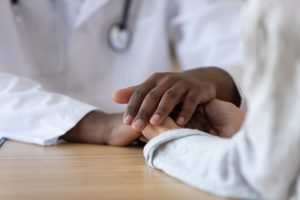By Lauren Peace, Tampa Bay Times | KFF Health News (TNS)
If you or someone you know may be experiencing a mental health crisis, contact the 988 Suicide & Crisis Lifeline by dialing or texting “988.”
____
For the most part, Cori Lint was happy.
She worked days as a software engineer and nights as a part-time cellist, filling her free hours with inline skating and gardening and long talks with friends. But a few days a month, Lint’s mood would tank. Panic attacks came on suddenly. Suicidal thoughts did, too.
She had been diagnosed with anxiety and depression, but Lint, 34, who splits her time between St. Petersburg, Florida, and Tulsa, Oklahoma, struggled to understand her experience, a rift so extreme she felt like two different people.
“When I felt better, it was like I was looking back at the experience of someone else, and that was incredibly confusing,” Lint said.
Then, in 2022, clarity pierced through. Her symptoms, she realized, were cyclical. Lint recognized a pattern in something her doctors hadn’t considered: her period.
For decades, a lack of investment in women’s health has created gaps in medicine. The problem is so prevalent that, this year, President Joe Biden signed an executive order to advance women’s health research and innovation.
Women are less likely than men to get early diagnoses for conditions from heart disease to cancer, studies have found, and they are more likely to have their medical concerns dismissed or misdiagnosed. Because disorders specifically affecting women have long been understudied, much remains unknown about causes and treatments.
That’s especially true when it comes to the effects of menstruation on mental health.
When Lint turned to the internet for answers, she learned about a debilitating condition at the intersection of mental and reproductive health.
Sounds like me, she thought.
What Is PMDD?
Premenstrual dysphoric disorder, or PMDD, is a negative reaction in the brain to natural hormonal changes in the week or two before a menstrual period. Symptoms are severe and can include irritability, anxiety, depression, and sudden mood swings. Others include fatigue, joint and muscle pain, and changes to appetite and sleep patterns, with symptoms improving once bleeding begins.
Unlike the mild discomfort of premenstrual syndrome, or PMS, the effects of premenstrual dysphoric disorder are life-altering. Those afflicted, according to one estimate, can endure almost four years of disability, cumulatively, over their lives.
Though researchers estimate that the dysphoric disorder affects around 5% of people who menstruate — about the same percentage of women with diabetes — the condition remains relatively unknown, even among health care providers.
In a 2022 survey of PMDD patients published in the Journal of Women’s Health, more than a third of participants said their family doctors had little knowledge of the premenstrual disorder or how to treat it. About 40% said the same was true of their mental health therapists.
Reproductive mental health has been sidelined as a specialty, said Jaclyn Ross, a clinical psychologist who researches premenstrual disorders as associate director of the CLEAR Lab at the University of Illinois-Chicago. Only some health care providers get training or even become aware of such disorders, Ross said.
“If you’re not considering the menstrual cycle, you’re at risk of misdiagnosing and missing what’s actually going on,” Ross said.
That was the case for Tampa, Florida, resident Jenna Tingum, 25, who had panic attacks and suicidal thoughts as a premed student at the University of Florida. It wasn’t until her college girlfriend read about PMDD online and noticed Tingum’s symptoms flared in the days leading up to her period that Tingum talked with her gynecologist.
“I don’t think I would have ever put the pieces together,” Tingum said.
Suicide Risk and Treatment
Because few researchers study the condition, the cause of PMDD is something of an enigma, and treatments remain limited.
It wasn’t until 2013 that the disorder was added to the Diagnostic and Statistical Manual, the handbook used by medical professionals in the U.S. to diagnose psychiatric conditions. PMDD was officially recognized by the World Health Organization in 2019, though references in medical literature date to the 1960s.
Related Articles
Lack of affordability tops older Americans’ list of health care worries
Santa Clara County investigating 19 deaths as possibly heat-related
Patient sings along to rock song during first awake kidney transplant at Northwestern Medicine
165 people sickened with salmonella after drinking raw milk from a central California farm
Magid: Keeping cool with AC, evaporative coolers, fans and an app
Defining the disorder as a medical condition faced early pushback from some feminist groups wary of giving credibility to stereotypes about PMS and periods. But Ross said patients must be taken seriously.
In one study, 72% of respondents with the disorder said they’d had suicidal thoughts in their lifetime. And 34% said they had attempted suicide, compared with 3% of the general population.
Marybeth Bohn lost her daughter, Christina Bohn, to suicide in 2021. It was only in the months before her death at age 33 that Christina connected her extreme distress to her cycle — no doctors had asked, Bohn said. Now Bohn, who lives in Columbia, Missouri, works with medical and nursing schools around the country to change curricula and encourage doctors to ask people in mental health emergencies about their premenstrual symptoms and cycles.
“We need more research to understand how and why these reactions to hormones occur,” Ross said. “There’s so much work to be done.”
While doctors haven’t settled on a universal approach to address the symptoms, three main treatments have emerged, said Rachel Carpenter, medical director of reproductive psychiatry at the University of Florida–Jacksonville College of Medicine.
Selective serotonin reuptake inhibitors, the most common form of antidepressants, are a first line of attack, Carpenter said. Some patients take the medication regularly; others in just the week or two that symptoms occur.
For some patients, hormonal birth control can alleviate symptoms by controlling or preventing the release of certain hormones.
Finally, talk therapy and cycle awareness can help patients build mental resilience for difficult weeks.
Sandi MacDonald, who co-founded the International Association for Premenstrual Disorders, a leading resource for patients and clinicians, said peer support is available through the nonprofit, but funding for research and education remains elusive.
She hopes the new White House initiative on advancing women’s health research will open doors.
Let’s Talk About Periods
Both Lint and Tingum, who were diagnosed by medical professionals after learning about the disorder on their own, said a lack of conversation around periods contributed to their care being delayed.
Lint doesn’t remember talking much about periods in grade school; they were often the butt of a joke, used to dismiss women.
“For the longest time, I thought, ‘Well, this happens to everyone, right?’” Lint said of her symptoms. “Has a doctor ever asked me what my symptoms are like? No, absolutely not. But we’re talking about a quarter or more of my life.”
Brett Buchert, a former University of Florida athlete who took time away from campus because her symptoms were so severe, said that when doctors do ask questions, it can feel like boxes being checked: “The conversation ends there.”
Buchert, who graduated with a degree in psychology and now lives in Boulder, Colorado, said understanding what’s happening to her and being aware of her cycle has helped her manage her condition.
Lint and Tingum agreed.
Even as Lint struggles to find a medicine that brings relief, tracking her cycle has allowed her to plan around her symptoms, she said. She makes fewer commitments in the week before her period. She carves out more time for self-care.
She’s also found solace in reading stories of others living with the condition, she said.
“It’s helped me process the extremes,” Lint said. “There’s not something wrong with me as an individual. I’m not crazy; this is something that’s legitimately happening to me. It helps to know I’m not alone.”
This article was produced through a partnership between KFF Health News and the Tampa Bay Times.
(KFF Health News is a national newsroom that produces in-depth journalism about health issues and is one of the core operating programs of KFF — the independent source for health policy research, polling and journalism.)
©2024 KFF Health News. Distributed by Tribune Content Agency, LLC.












